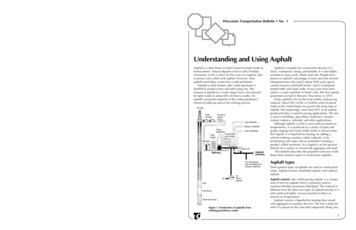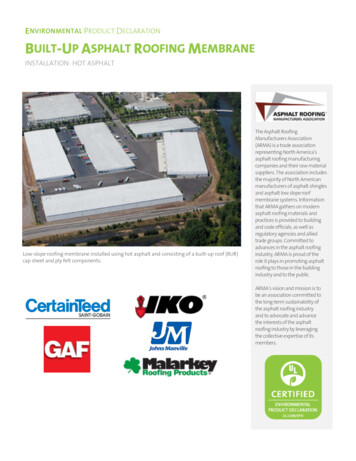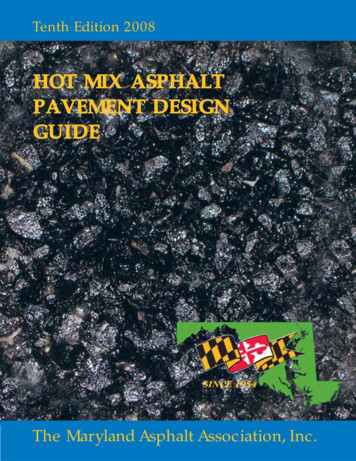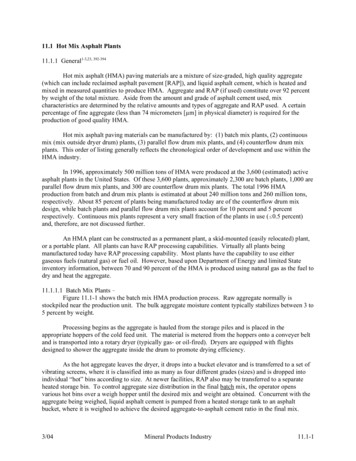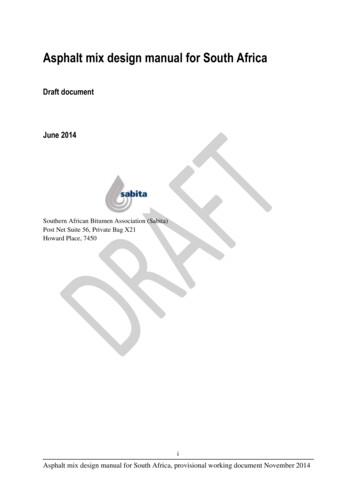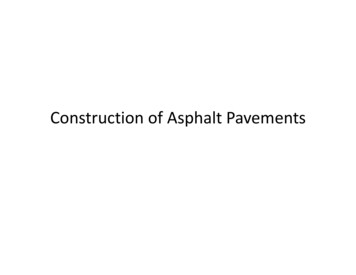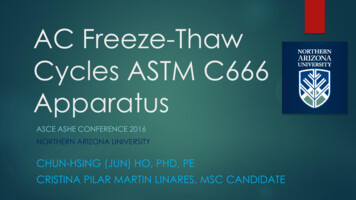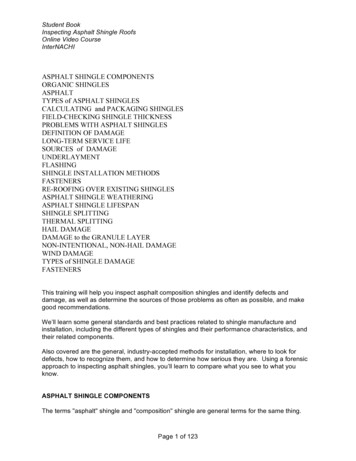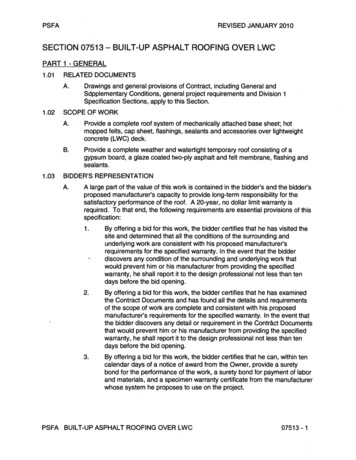
Transcription
PSFAREVISED JANUARY 2010SECTION 07513- BUILT-UP ASPHALT ROOFING OVER LWCPART 1 - GENERAL1.01RELATED DOCUMENTSA.1.021.03Drawings and general provisions of Contract, including General andSllpplementary Conditions, general project requirements and Division 1Specification Sections, apply to this Section.SCOPE OF WORKA.Provide a complete roof system of mechanically attached base sheet; hotmopped felts, cap sheet, flashings, sealants and accessories over lightweightconcrete (LWC) deck.B.Provide a complete weather and watertight temporary roof consisting of agypsum board, a glaze coated two-ply asphalt and felt membrane, flashing andsealants.BIDDER'S REPRESENTATIONA.A large part of the value of this work is contained in the bidder's and the bidder'sproposed manufacturer's capacity to provide long-term responsibility for thesatisfactory performance of the roof. A 20-year, no dollar limit warranty isrequired. To that end, the following requirements are essential provisions of thisspecification:1.By offering a bid for this work, the bidder certifies that he has visited theand determined that all the conditions of the surrounding andunderlying work are consistent with his proposed manufacturer'srequirements for the specified warranty. In the event that the bidderdiscovers any condition of the surrounding and underlying work thatwould prevent him or his manufacturer from providing the specifiedwarranty, he shall report it to the design professional not less than tendays before the bid opening. ite2.By offering a bid for this work, the bidder certifies that he has examinedthe Contract Documents and has found all the details and requirementsof the scope of work are complete and consistent with his proposedmanufacturer's requirements for the specified warranty. In the event thatthe bidder discovers any detail or requirement in the Contrc\ct Documentsthat would prevent him or his manufacturer from providing the specifiedwarranty, he shall· report it to the design professional not less than tendays before the bid opening.3.By offering a bid for this work, the bidder certifies that he can, within tencalendar days of a notice of award from the Owner, provide a suretybond for the performance of the work, a surety bond for payment of laborand materials, and a specimen warranty certificate from the manufacturerwhose system he proposes to use on the project.PSFA BUILT-UP ASPHALT ROOFING OVER LWC07513 - 1
PSFA1.04REVISED JANUARY 2010QUALIFICATIONSA.B.Manufacturer Qualifications1.The manufacturer of the roofing system shall be the actual manufacturerof the roofing and insulation component materials, and shall have not lessthan fifteen (15) years experience in the production of the specifiedsystem. 2.The contractor shall include a certification from the manufacturer, on themanufacturer's letterhead, that the proposed membrane and insulationmaterials will be produced by the manufacturer of record.Installer Qualifications1.1.051.06The installer of the built-up roofing shall have been engaged in thebusiness of installing built-up roofing for not less than five (5) years andshall be experienced in the layout and application of this material. Thecrew shall be composed of experienced and skilled workers in this work.SU BM ITTALSA.Shop Drawings: Submit in accordance with Conditions of Contract and Division1 Specification Sections, indicating roof size, membrane attachment layout,location, and type of penetrations, perimeter and penetration details, roofinsulation make-up and layout.B.Product Data Submittals: Include manufacturer's technical product data,including UL product listing for each type of insulation, deck, fasteners androofing product required.C.Fire Resistance: Provide roofing system, insulation, and component materialsthat have been tested for application and slopes indicated and are listed byUnderwriters Laboratories, Inc. (UL) for Class A external fire exposure overdecks specified herein.D.Wind Uplift: Provide rigid insulation, mechanically fastened roofing system, andcomponent materials suitable for the structural deck and that have been testedas a complete system for application and slopes indicated. Provide a completeoutfit of submittals ready for review. Allow sufficient time for review of thesubmittal. Provide fastening for uplift resistance to meet the applicable BuildingCode but in no case le s than 90 psf.INSPECTIONSA.During the roofing system installation, 5 digital photos shall be taken daily of thework progress. The photos shall be forwarded to the Design Professional andthe Owner daily with a brief caption of the roofing area being installed and theproducts being used.B.After the roof installation is complete, the manufacturer shall inspect the workand inform (by written report) the design professional, contractor, and theinstaller of defective/incomplete work to be remedied. Those areas indicatedshall be corrected to the full satisfaction of the design professional, Owner, andmanufacturer. The manufacturer shall submit written acceptance of the projectto the design professional to issuance of the weather-tightness warranty.PSFA BUILT-UP ASPHALT ROOFING OVER LWC07513 - 2
PSFAREVISED JANUARY 2010c.1.071.08Inspections shall be performed at each transition of roof detail encountered foreach phase of roofing for the duration of the project. An experienced, full-timeemployee of the manufacturer, with experience in similar inspections over thepast two years, must conduct each inspection.WARRANTYA.Manufacturer's Warranty:. Provide roofing manufacturer's total system leak-tight20-year No Dollar Limit Warranty, including insulation. Provide all detailsnecessary to qualify for manufacturer's 20-year "No Dollar Limit Warranty".B.Roofer's Guarantee: Provide written guarantee from the Contractor stating thatthe Contractor will respond within 24 hours and repair within 5 business days,any leaks or defects in the roofing assembly for 1 years at no cost to the Owner.ENVIRONMENTAL REQUIREMENTSA.Install roofing materials only when surfaces are clean, dry, smooth and free ofsnow or ice.B.Do not apply roofing membrane during inclement weather or when ambientconditions will not allow proper application. Consult manufacturer's technicalspecifications on cold weather application.C.If during the course of this project, the rooftop mechanical equipment (heatingand/or cooling) must be taken out of service to accomplish the work, the GeneralContractor shall provide temporary portable heating and/or cooling systems tomaintain the building's interior environment equal to the building's own heatingand/or cooling system.PART 2- PRODUCTS2.01MANUFACTURERA.2.02Provide a mechanically attached base sheet, four ply felt with a one ply mineralsurfaced fiberglass cap sheet built-up roofing system. This is a minimumperformance specification. Other manufacturer's systems may qualify, asdetermined by the design professional.ROOF INSULATION PRODUCTSA.Gypsum Board (Substrate for Temporary Roof): Non-structural, moistureresistant gypsum panel. Gypsum board shall conform to ASTM C 1177 or ASTMC 1278. Gypsum board shall be supplied 4' x 8' sheets. Gypsum board shall beflat stock 5/8" thick. Gypsum board shall be pre-primed or field primed asapplicable.·B.Perlite can't strip complying with ASTM C-728.C.Mechanical Fasteners: Provide fasteners and plates listed in the approvedreport as part of the total assembly proposed. Fasteners shall be installed inpatterns as required for the specified rigid insulation by the manufacturer toproduce the required wind uplift resistance.PSFA BUilT-UP ASPHALT ROOFING OVER LWC07513 - 3
PSFA2.03REVISED JANUARY 2010TEMPORARY ROOFA.B.Approved Roof1.Johns Manville Roofing Systems Group2.GAF Material CorporationRoofing Felts1.C.Ply Sheets: Two plies of asphalt-impregnated glass fiber mat complyingwith ASTM D 2178, Type IV.Roofing Bitumens1.Low fuming/low odor asphalt bitumen complying with ASTM D 312.Asphalt shall be domestically manufactured in the United States and asapproved by the roofing system manufacturer.a.2.D.i.Trulo by Owens Corning Trumbullii.No Smell Asphalt by Continental Materialsiii.No Smell Asphalt by United Asphaltiv.Hot Stuff Asphalt's "Lite Packs"b.lnterply moppings - Type Ill, IVc.Glaze coat- Type Illd.Flashings - Type Ill or IV, as recommended by manufacturerContractor shall provide and maintain a fume recovery system acceptableto the owner for the duration of the project to control fumes/odorsassociated with bitumen kettles.Base Flashing Materials: Two plies of asphalt - impregnated glass fibernot complying with ASTM D 2178, Type IV.Asphalt Roof Cement1.G.Approved ProductsFlashings1.E.To comply with ASTM D 4586, asphalt roof cement (asbestos free) orroofing membrane manufacturer supplied SBS modified asphalt roofcement (asbestos free), as required.Related Materials1.Flashing securement devices shall be of adequate design to achievesubstantial and positive anchorage.a.Anchor bars for flashing securement to concrete or masonrysubstrates shall be 1/8" x 1" flat aluminum bar with 8" holespacing by OMG, or approved equal.PSFA BUILT-UP ASPHALT ROOFING OVER LWC07513 - 4.
PSFA2.04REVISED JANUARY 2010ROOF SYSTEMA.B.Approved Manufacturer1.Johns Manville Roofing Systems Group, Specification 6GLC2.GAF Material Corporation, Specification N-B-6-M-/P6Roofing Felts. 1.Ply Sheets: Four plies of asphalt-impregnated glass fiber mat complyingwith ASTM D 2178, Type VI.2.Felt Envelopes: Non-perforated, asphalt-saturated organic roof feltcomplying with ASTM D 226, Type I.3.Mineral surfaced fiberglass cap sheet complying with ASTM D 3909.a.b.GlasKap by Johns Manville (GlasKap CR for LEED projects)GAF Glas Mineral Cap Sheet by GAF (EnergyCap for LEEDprojects)4.C.Venting base sheet complying with ASTM D 4897, Type II. One ply on alllightweight concrete decks.a.Vensulation by Johns Manvilleb.Stratavent by GAFRoofing Bitumens1.Low fuming/low odor asphalt bitumen complying with ASTM D 312.Asphalt shall be domestically manufactured in tl:le United States and asapproved by the roofing system manufacturer.a.2.D.Approved Productsi.Trulo by Owens Corning Trumbullii.No Smell Asphalt by Continental Materialsiii.No Smell Asphalt by United Asphaltiv.Hot Stuff Asphalt's by "Lite Packs"b.lnterply moppings - Type Ill, IVc.Glaze coat - Typed.Flashings - Type Ill or IV, as recommended by manufacturermContractor shall provide and maintain a fume recovery system acceptableto the Owner for the duration of the project to control fumes/odorsassociates with bitumen kettles.Flashings1.Base Flashing Materials: Two plies of material base ply shall be a SBSpolymer modified bitumen reinforced with a polyester and/or glass fibermat. (Top ply shall be the highly reflective fiberglass reinforced mineralcap sheet if a LEED project).PSFA BUILT-UP ASPHALT ROOFING OVER LWC07513 - 5
PSFAREVISED JANUARY 2010a.b.Dynalastic 180S and Glaskap (CR for LEED projects) by JohnsManville Roofing Systems Group.Ruberoid Mop Smooth and GAF Glas Mineral Cap (EnergyCap forLEED projects) by GAF Material Corp.2.E.Strip Flashing Materials: One ply of granule-surfaced SBS polymer· modified bitumen sheet reinforced with a polyester and/or glass fiber mat:a.Dynalastic 180S by Johns Manville Roofing System Groupb.Ruberoid Mop Smooth by GAF Material CorporationWalkways1.Granule-surfaced modified asphalt boards:a.F.Asphalt Roof Cement1.G.Dyna Tred by Johns Manville Roofing Systems GroupTo comply with ASTM D 4586, asphalt roof cement (asbestos free) orroofing membrane manufacturer supplied SBS modified asphalt roofcement (asbestos free), as required.Related Materials1.Lead Flashing for roof drains shall be 27'' x 27'' and be minimum 4 poundlead.2.Pipe or vent jackets shall be minimum 3 pound lead with cap designed foruse on flat roof construction.3.Perrna-Flash is an acceptable alternative to lead pipe jackets. PermaFlash system requires 1 coat of TopGard Base Coat and 2 coats ofTopGard 4000 to final product.3.Wood Nailers: Shall be FTRW only on any roofing surfaces.4.Flashing securement devices shall be of adequate design to achievesubstantial and positive anchorage.a. Anchor bars for flashing securement to concrete or masonrysubstrates shall be 1/8" x 1" flat aluminum bar with 8" hole spacing byOMG, or approved equal.PART 3 - EXECUTION3.01INSPECTIONA.The contractor shall be responsible for suitable substrate to accept the roofingsystem.B.Installer of roofing system shall examine substrate and conditions under whichroofing work is to be performed and shall notify the Architect and Ownerrepresentative immediately of unsatisfactory conditions. Do not proceed withroofing work until unsatisfactory conditions have been corrected in manneracceptable to installer and manufacturer.PSFA BUilT-UP ASPHALT ROOFING OVER LWC07513 - 6
REVISED JANUARY 2010PSFAc.Before roofing work may begin, the design professional shall conduct a preroofing coordination meeting. It shall be attended by the Owner's representative,the PSFA representative, as necessary, the general contractor, the roofingcontractor, the roofing manufacturer's representative and all othersubcontractors who have any components of their work on or penetrating theroof. The participants shall:1. As much as is possible by visual inspection and by the cutting of co.resamples, verify that surfaces and site conditions are ready to receive work.2. Examine roof deck to determine that it is sufficiently rigid to support roofersand their mechanical equipment and that deflection will not strain or ruptureroof components or deform deck.3. Verify deck is clean and smooth, free of depressions, waves, or projections,properly sloped to insure drainage. Examine substrate to determine thatsurface is in a suitable condition for roofing work.4. Verify roof openings, curbs, pipes, sleeves, ducts, and vents through roof aresolidly set, and cant strips, wood nailing strips and reglets are in place.Verify that all curbs and penetrations have been laid out and installed withadequate vertical and horizontal clearance as required by the manufacturerto provide the specified warranty.5. The condition of surface to receive roof insulation shall be firm, clean,smooth, and dry. Do not start roof application until defects have beencorrected.3.023.03INSTALLATIONA.General: Comply with manufacturer's written instruction for installation of theroof system.B.All flashings shall be installed concurrently with the roofing membrane as the jobprogresses. No temporary flashings shall be allowed without the prior writtenapproval of the Owner's Representative. If any water is allowed to enter underthe newly completed roofing due to incomplete flashings, seams and or nightseals, the affected area shall be removed and replaced at the Applicator'sexpense.C.Phased Construction & Completion Requirements1.Phased construction will not be permitted on this project.2.Once roofing is started the roofing application must be finalized and allpunch lists completed incalendar days.WOOD NAILER LOCATION AND INSTALLATIONA.Nailers are to be installed as per detail drawings.B.Discard units of material with defects that might impair quality of work and unitsthat are too small to use in fabricating work with minimum joints or optimum jointarrangement.C.Set nailers to required levels and lines with members plumb and true.D.All perimeter nailers shall be of uniform height within a given roof section.PSFA BUILT-UP ASPHALT ROOFING OVER LWC07513 - 7
REVISED JANUARY 2010PSFAE.Nailers shall be installed with W' gap between ends of adjoining pieces.F.Nailers shall be fastened in accordance with the following schedule:1.Fasteners in 6" or wider (nominal) lumber shall be installed in two (2) rows,staggered one-third of nailer width. Listed spacings indicate distancebetween fasteners in adjacent rows.2. Two (2) fasteners shall be installed within 6" of each nailer end.3.Corner fastener spacing shall extend 8' from all outside building corners.4.Where two or more nailers are installed, each nailer shall be fastenedindependently.5.Over all deck types, the bottom nailer shall be fastened using the specifiedfasteners and 5/8" diameter washers. Countersink washers .and fastenerslevel with top of wood using spade bit or similar method. Fasten subsequentnailers, where specified, using the specified screws without washers.6.When nailers are stacked, stagger the layer ends no less than 24".7.Nailer Attachment Schedule (unless noted otherwise on the drawings)Attachment SubstrateStructural ConcreteCMU (fastener into solidmaterial)Steel DeckWood3.04Perimeter FastenerSpacing (maximum)12" o.c12" o.cCorner Fastener Spacing(maximum)6" o.c6"o.c12" o.c12" o.c6" o.c6" o.cINSULATION INSTALLATION (SUB.STRATE FOR THE TEMPORARY ROOF)A.Install Insulation: Install only as much insulation as can be covered with thetemporary roof and completed before the end of the day's work or before theonset of inclement weather.B.Fit Insulation: Neatly fit insulation to all penetrations, projections, and nailers.Insulation should be loosely fitted, with gaps greater than 1/4" being filled withacceptable insulation. Under no circumstances should the membrane be leftunsupported over a space greater than 1/4". Tapered or feathered insulationshould be installed around roof drains so as to provide proper slope for drainage.C.Attach Insulation: Insulation must be attached using Fasteners and InsulationPlates. Refer to the Technical Information for attachment patterns and rates forspecific insulation types and thickness. In a multi-layer insulation assembly, thetype and thickness of the top layer of insulation determine fastening pattern.Insulation fasteners shall penetrate the top of the flutes and shall not extend intothe building interior. Roofing contractor is liable for replacing fasteners thatextend beyond the bottom of the flutes.D.Stagger Insulation Joints: When installing multiple layers of insulation, all jointsbetween layers should be staggered.PSFA BUILT-UP ASPHALT ROOFING OVER LWC07513 - 8
PSFA3.05REVISED JANUARY 2010TEMPORARY ROOF INSTALLATIONA.Asphalt Bitumen Heating: Heat and apply bitumen in accordance withequiviscous temperature method ("EVT Method") as recommended by NRCA.Do not raise temperature above minimum normal fluid-holding temperaturenecessary to attain EVT (plus 25 F at point of application) more than one hourprior to time of application. Discard bitumen that has been held at temperature,exceeding finished blowing temperature (FBT) for a period exceeding 3 hours.B.Contractor shall provide and maintain a fume recovery system acceptable to theOwner for the duration of the project to control fumes/odors associated withbitumen kettles.C.Quality Control: Contractor's asphalt kettle shall be equipped with an accuratebuilt-in thermometer. Contractor shall also have available at the site andadditional portable thermometer for checking temperature of asphalt at the pointof application and for use as a check on the kettle thermometer.D.Bitumen Mopping Weights: For interplay mopping, and for other moppingsexcept as otherwise indicated, apply bitumen at the rate of 25 pounds of asphalt(plus or minus 25 percent on a total-job average basis) per roof square (100sq.ft.) between plies.E.Substrate Joint Penetrations: Do not allow bitumen to penetrate substrate jointsand enter building or other construction. Where mopping is applied directly to asubstrate, tape joints or, in the case of steep asphalt, hold mopping back 2inches from both sides of each joint.F.Cutoffs: At end of each day's roofing installation, protect exposed edge ofincomplete work, including ply sheets and insulation. Provide temporarycovering of 2 plies of No. 15 roofing felt set in full moppings of hot bitumen;remove at beginning of next day's work. Glaze-coat areas of completed organicply sheets before end of each day's work.G.If applicable prime the substrate board or concrete deck with ASTM D 41 asphaltprimer at the rate of 3A gallon per 100 per square feet. The primer shall beallowed to dry prior to temporary roof application.H.The temporary roofs shall consist of two-plies ASTM D 2178 Type IV glass feltsinstalled in uniform solid mopping of ASTM D 312 Type 111 low fuming/low odorasphalt over a primed concrete deck or a primed ubstrate board.I.Four inch (4") cants shall be fully adhered at all wall/curb transitions.J.Flashing shall consist of two-plies of ASTM D 2178 Type IV glass felts installedin uniform solid mopping of ASTM 312 Type ltl low fuming/low odor asphalt.Flashing shall extend a minimum of 6" above the roof deck. The top edge of allflashing shall be fastened at 6" o.c. with 1" cap nails or otherappropriate/approved fastener. The top edge of all flashing shall be threecoursed with roof cement and reinforcement fabric.K.All temporary roofing and flashing shall be glazed coated with asphalt at the endof each working day.PSFA BUilT-UP ASPHALT ROOFING OVER LWC07513 - 9
PSFA3.06REVISED JANUARY 2010MEMBRANE AND FLASHING INSTALLATIONA.Asphalt Bitumen Heating: Heat and apply bitumen in accordance withequiviscous temperature method ("EVT Method") as recommended by NRCA.Do not raise temperature above minimum normal fluid-holding temperaturenecessary to attain EVT (plus 25 F at point of application) more than one hourprior to time of application. Discard bitumen that has been held at temperature,exceeding finished blowing temperature (FBT) for period exceeding 3 hours.aB.Quality Control: Contractor's low fume recovery equipped asphalt kettle shall beequipped with an accurate built-in thermometer. Contractor shall also haveavailable at the site and additional portable thermometer for checkingtemperature of asphalt at the point of application and for use as a check on thekettle thermometer.C.Bitumen Mopping Weights: For interply mopping, and for other moppings exceptas otherwise indicated, apply bitumen at the rate of 25 pounds of asphalt (plus orminus 25 percent on a total-job average basis) per roof square (100 sq. ft.)between plies.D.Substrate Joint Penetrations: Do not allow bitumen to penetrate substr te jointsand enter building or damage insulation, vapor retarders, or other construction.Where mopping is applied directly to a substrate, tape joints or, in the case ofsteep asphalt, hold mopping back 2 inches from both sides of each joint.E.Cutoffs: At end of each day's roofing installation, protect exposed edge ofincomplete work, including ply sheets and insulation. Provide temporarycovering of 2 plies of No. 15 roofing felt set in full moppings of hot bitumen;remove at beginning of next day's work. Glaze-coat areas.of completed organicply sheets before end of each day's work.F.Base Sheet: Ventilating base sheet at all designated locations. Mechanicallyfasten as required to provide required wind uplift resistance.G.Roof Membrane Installation: Apply a piece g wide, then over that, one 18" wide,then over that, one 27" wide. Over these 3 partial sheets install a full width 36"piece. The following felts are to be applied full width, overlapping the precedingfelts by 27-1/2" so that at least 4 plies of felt cover the substrate at all locations.Install each felt so that it is firmly and uniformly set, without voids, into the hotbitumen (within 25 F of the EVT) applied just before the felt at a nominal rateof 23 lbs. per square, over the entire surface. Installation over porous substratessuch as roof insulation may require up to 33 lbs. of hot bitumen per square.H.Surfacing: Prior to application of the fiberglass reinforced mineral surfaced capsheet, cut the cap sheet into handle able lengths (12' -18'). Lay the material outon the roof and allow it to relax and flatten. To accommodate a full width sheet,apply a mopping of hot asphalt, approximately 20 F above the EVT, at a nominalrate of 25 lbs. per square. (The higher temperature of asphalt maximizes thebonding of the cap sheet to the ply felts.) Then flop the cap sheet into the hotasphalt. On subsequent courses, the cap sheet is positioned upside down,directly over the sheet in the preceding course such that the side lap area of thepreceding sheet is exposed. Care should be taken to maintain 2" side laps and6" end laps. Asphalt is applied in the same manner as before, making sure toPSFA BUILT-UP ASPHALT ROOFING OVER LWC07513 - 10
REVISED JANUARY 2010PSFAalso cover the 2" exposed side lap. Asphalt may also be applied to the exposed"upside down" cap sheet, prior to "flopping" it into the hot asphalt. The cap sheetmust by firmly and uniformly set, without voids, into the hot asphalt with all edgesand laps well sealed.I.Care shall be taken not to track bitumen onto the finished exposed membrane.Full adhesion shall be achieved and all edges shall be well sealed. Leading andtrailing edges of T-laps in both plies shall be hand rolled to prevent formation ofvoids. Asphalt shall bleed out "to Y2"at laps. #11 color matched granules shallbe broadcast into asphalt bleed out while hot so that the finished appearance isuniform and neat.J.Set-On Accessories: Where small roof accessories are set on built-up roofingmembrane, set metal flanges in a bed of roofing cement and seal penetration ofmembrane with bead of roofing cement to prevent flow of bitumen from·membrane.K.Composition Flashing and Stripping: Install composition flashing at cant stripsand other sloping and vertical surfaces, at roof edges, and at penetrationsthrough roof.L.Application of Base Flashing: The roofing membrane must extend to the top ofthe cant. The completed base flashing shall extend not less than 9" nor morethan 24" above the level of the roof, and shall extend onto the roof membrane aminimum of 4".1.Starting just below the point on the parapet where the base flashing willterminate, mop the parapet and the surface of the roofing felts on thecant with hot Type Ill or Type IV asphalt. Immediately place the backerfelt into the hot bitumen, smoothing the felt to set it firmly into thebitumen. The bottom edge of the backer felt should.terminate at thebottom edge (base) of the cant. Do not extend the backer felt onto thehorizontal membrane surface. Laps in the backer felt should be aminimum of 2".2.All flashings shall be installed in 39" long pieces, cut from the end of theroll. Starting just above the top edge of the backer felt, mop the wall, thesurface of the backer felt, and out onto the roof membrane with hot TypeIll or IV asphalt. Holding the upper corners of the flashing, position itslower horizontal edge on the roof membrane (minimum 4" from ba se ofthe cant) and lay it into place over the cant strip and up the wall. Thesheet should be ''worked in" to ensure that it is firmly and uniformlybonded. In cool or cold weather, the back of the flashing sheet shouldalso be mopped with the hot bitumen, and shorter lengths of flashingshould be used. Laps in the flashing should be minimum of 3" and bewell sealed.3.Mechanically fasten the base flashing on 6" centers along its top edge.Fasteners must have a ·1" minimum diameter integral cap, or be driventhrough 1" minimum diameter rigid metal discs.PSFA BUILT-UP ASPHALT ROOFING OVER LWC07513 - 11
PSFAREVISED JANUARY 20104.3.07M.Roof Drains: Fill clamping ring base with a heavy coating of roofing cement.Extend built-up roofing membrane into clamping ring or, where not feasible,provide two plies of glass-fiber-reinforced flashing mopped with Type Ill asphaltand extended into clamping ring. Extend flashings onto built-up asphalt roofi ngsystem 6 inches and 10 inches, respectively. Before placing clamping ring, set 2plies of glass-fiber fabric in roofing cement and coat with roofing cement. Extendeach fabric into clamping ring and for distances of 14 inches and 16 inches,respectively, onto built-up roofing.N.Installation of Roof Accessories: Miscellaneous sheet metal accessory items,including insulation vents and other devices, and major items of roof accessories(if any) to be coordinated with built-up roofing system work, are specified in othersections of these specifications.PROTECTIONA.3.08Protect building surfaces against damage from roofing work. Where traffic mustcontinue over finished roof membrane, protect surfaces.TEMPORARY CLOSUREA.3.09All inside and outside corners and vertical laps shall be three-coursedwith asphalt roof- cement and reinforcing fabric, with #11 color matchedgranules broadcast and pressed into the cement while wet.Temporary closures to ensure that moisture does not damage any completedsection the new roofing system are the responsibility of the roofing contractor.Completion of flashing, terminations, and temporary closures should becompleted as required to provide a watertight condition. Any materialcontaminated by a temporary closure must be cut out and discarded prior toresumption of installation.CLEANUPA.Remove bituminous markings from finished surfaces.B.In areas where finished surfaces are soiled by work of this Section, consultmanufacturer of surfaces for cleaning advice and conform to their instructions.C.Remove excess materials, trash, debris, equipment, and parts from the Work.D.Repair or replace defaced or disfigured finishes caused by work of this Section.- End' of Section -PSFA BUilT-UP ASPHALT ROOFING OVER LWC07513 - 12
1. Johns Manville Roofing Systems Group 2. GAF Material Corporation Roofing Felts 1. Ply Sheets: Two plies of asphalt-impregnated glass fiber mat complying with ASTM D 2178, Type IV. C. Roofing Bitumens 1. Low fuming/low odor asphalt bitumen complying with ASTM D 312. Asphalt shall be domestically manufactured in the United States and as

